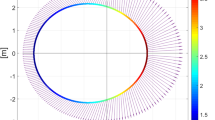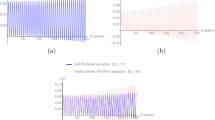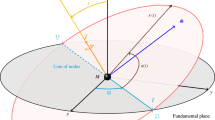Summary
The orbits of artificial satellites about celestial bodies can be chosen to optimize the precision of a measurement of the precession of satellite perihelia. Experiments with satellites in optimized orbits appear capable of testing the precessional formula of general relativity with greater precision than heretofore. Maximizing a precessional figure of merit based upon the observational techniques of planetary astronomy leads to the optimal orbital condition that the ratio of the semi-major axis to the semi-minor axis of the elliptical orbit is equal to √3. In MKS units, the magnitude of the angular advance of satellite perihelia is ψ0(seconds of are/century)=5.0·10−19(M 3/2/r 5/2), whereM is the mass of the celestial body, andr is the perihelion distance. For a given ratio of perihelion distance to the radius of the celestial body, the Sun causes a satellite to precess from about two to three orders of magnitude more than the jovian planets and from about three to four orders of magnitude more than the terrestrial planets. Although the precession of the perihelion of a satellite in an optimized orbit about the Earth is comparable with that from the planet Mercury about the Sun, the observational figure of merit for an optimized Earth satellite is several times that of Mercury. The observational figure of merit for an optimized Moon satellite is comparable with that for the planet Mercury.
Riassunto
Si possono scegliere le orbite dei satelliti artificiali attorno ai corpi celesti in modo da rendere ottima la precisione delle misure della precessione dei perieli dei satelliti. Gli esperimenti con satelliti artificiali in orbite rese ottime sembrano atti a verificare la formula delle precessioni della relatività generale con maggiore precisione dell’attuale. Per rendere massima la cifra di merito della precisione sulla base delle tecniche di osservazione dell’astronomia planetaria bisogna rispettare la condizione orbitale di ottimo, cioè che il rapporto fra il semiasse maggiore ed il semiasse minore dell’orbita ellittica sia uguale a √3. In unità MKS, la grandezza dei perieli dei satelliti è ψ0 (secondi di arco/secolo)=5.0·10−19 (M 3/2/r 5/2), in cuiM è la massa del corpo celeste edr è la distanza del perielio. Per un dato rapporto fra la distanza del perielio ed il raggio del corpo celeste, il Sole causa una precessione del satellite di due o tre ordini di grandezza maggiore di quella dei pianeti gioviani e di tre o quattro ordini di grandezza maggiore di quella dei pianeti terrestri. Sebbene la precessione del perielio di un satellite in un’orbita resa ottima attorno alla Terra sia confrontabile con quella del pianeta Mercurio attorno al Sole, la cifra di merito di osservazione dell’orbita di un satellite della terra resa ottima è parecchie volte maggiore di quella dell’orbita di Mercurio. La cifra di merito di osservazione di un satellite della Luna resa ottima è confrontabile con quella dell’orbita del pianeta Mercurio.
Similar content being viewed by others
References
A. Einstein:Ann. der phys.,49, (1916)
R V. Pound andG. A. Rebka:Phys. Rev. Lett.,4, 337 (1960).
G. M. Clemence:Rev. Mod. Phys.,19, 361 (1947).
G. M. Clemence:Proc. Am. Phil. Soc.,93, 532 (1949).
J. J. Gilvarry:Phys. Rev.,89, 1046 (1953).
J. J. Gilvarry:Pub. Astron. Soc. Pacific,65, 173 (1953).
V. L. Ginzburg:Experimental verification of the general theory of relativity, inRecent Developments in General Relativity (London, 1962), p. 57.
J. J. Gilvarry:Nature,183, 666 (1959).
L. Lapaz:Pub. Astron. Soc. Pacific,66, 13 (1954).
Author information
Authors and Affiliations
Rights and permissions
About this article
Cite this article
Goldberg, I., Madey, E. Precession of satellite orbits and general relativity. Nuovo Cimento B (1965-1970) 41, 1–8 (1966). https://doi.org/10.1007/BF02711109
Received:
Published:
Issue Date:
DOI: https://doi.org/10.1007/BF02711109




